#galapagos
Text

Sea lion meets Iguana, Puerto Ayora, Galapagos, Ecuador: Puerto Ayora is a town in central Galápagos, Ecuador. Located on the southern shore of Santa Cruz Island, it is the seat of Santa Cruz Canton. The town is named in honor of Isidro Ayora, an Ecuadorian president. The town is sometimes mistakenly referred to as Santa Cruz. Wikipedia
63 notes
·
View notes
Text
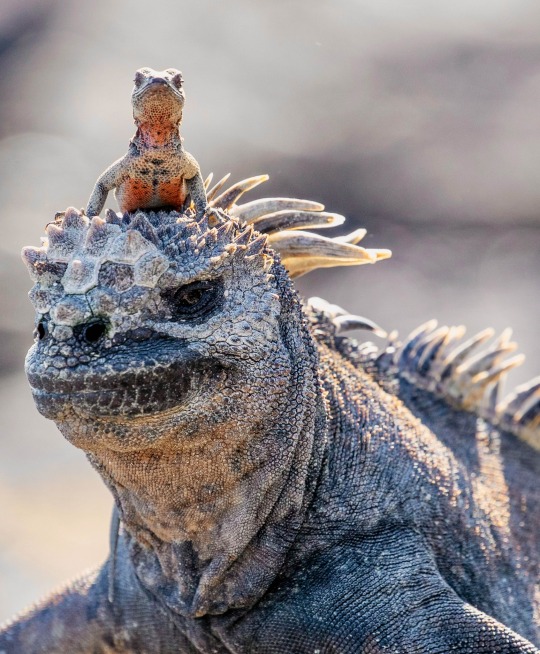

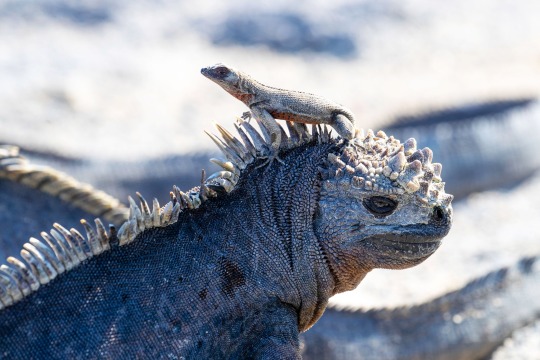
Galapagos Lava Lizard (Microlophus albemarlensis), family Tropiduridae, sitting on a Marine Iguana (Amblyrhynchus cristatus), family Iguanidae, Fernandina Island, Galapagos
photographs by Rachelle Mackintosh
#lava lizard#tropiduridae#microlophus#iguana#amblyrhynchus#iguanidae#lizard#reptile#herpetology#animals#nature#galapagos
6K notes
·
View notes
Photo
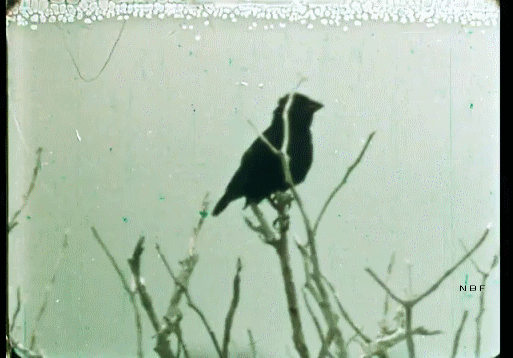
From a documentary on the Galapagos Finches, 1970s
3K notes
·
View notes
Text
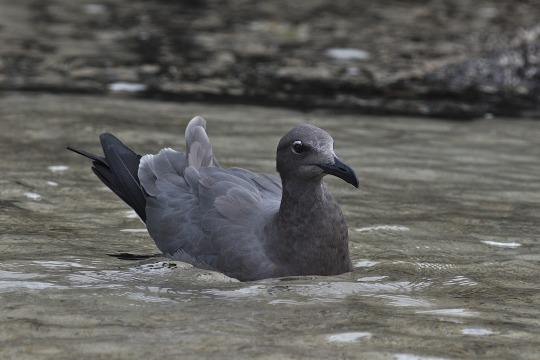
Lava gulls are the rarest gulls in the world and closely related to laughing and Franklin’s gull.
(Lava gull)
#photography#art#outdoors#nature#animals#digital art#wildlife#adventure#birds#outdoor#galapagosexpeditionann#galapagos#seabirds
2K notes
·
View notes
Text
Baby Galapagos Pink Land Iguanas Observed for the First Time
For the first time ever baby Galapagos pink land iguanas have been observed! The critically endangered species has an estimated adult population of 200-300 animals, which researchers worried were beginning to decline due to age. A ten month search found nesting sites and hatchlings on Isabela Island, in a remote area near Wolf Volcano. Like the name suggests adult Galapagos pink land iguanas are a shade of bright pink, however, babies are bright green with black spots.
[Photo credit: Galapagos National Park]

3K notes
·
View notes
Text

This spooky season, meet a bird that feasts on blood. 🩸The Hood Mockingbird (Mimus macdonaldi) can be found on the Galapagos’ Española Island. Weighing in at about 2.5 oz (70 g), it typically dines on bird eggs, arthropods, and lizards. But during dry seasons, this bird uses its long hooked beak to probe the flesh of animals like iguanas, sea lions, and albatrosses—sucking up their blood to drink.
Photo: Anne Haase, CC BY-ND 2.0, flickr
#animals#nature#bird#ornithology#mockingbird#galapagos#cool animals#fact of the day#did you know#natural history
560 notes
·
View notes
Text
"A coral reef with flourishing marine life has been discovered off Ecuador's Galapagos Islands.
A scientific expedition traced the 1.2-mile-long (2km) reef to the top of an underwater mountain formed by volcanic activity - 400m (1,300ft) deep.
Ecuador's environment minister, Jose Davalos, said the exploration team "found the first totally pristine coral reef... on the summit of a submarine mountain".
The previously unknown underwater colony comes as a surprise to scientists, who believed only one reef existed in the volcanic archipelago - Wellington - along the coast of the tiny Darwin Island.
Reefs in the area were severely degraded during El Niño weather in 1982-83 when the ocean surface warmed to devastating levels.
However, the newly discovered reef survived the event and has more than 50% living coral.
Mr. Davalos tweeted: "Galapagos surprises us again."

Senior marine researcher at the Charles Darwin Foundation and expedition participant, Stuart Banks, said: "This is very important at a global level because many deepwater systems are degraded."
He added the coral dated back several thousand years.
Ecuador expanded the Galapagos marine reserve by more than 20,000 square miles last year to protect endangered migratory species between the archipelago and Cocos Island in Costa Rica.
Many endangered animals live on the islands including giant tortoises, albatrosses and cormorants."
-via Sky News UK, 4/18/23
#coral#coral reef#underwater#galapagos#ecuador#costa rica#marine science#endangered species#migratory birds#good news#hope
1K notes
·
View notes
Text
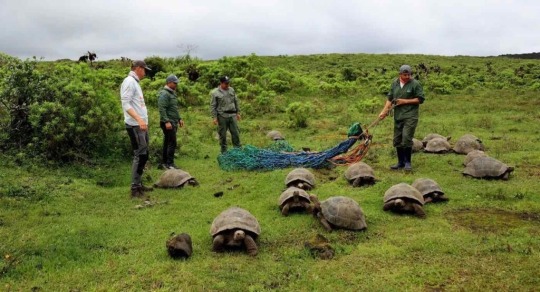
#good news#environmentalism#science#nature#animals#galapagos#galapagos tortoise#tortoises#giant tortoise#conservation#environment
170 notes
·
View notes
Text
HEY. YOU.

YEAH. YOU.
IT'S TIME TO LEARN ABOUT MARINE IGUANAS.
#animals#science#biology#nature#conservation#wildlife#environment#ecology#zoology#reptiles#reptiblr#lizards#ocean#Galapagos
294 notes
·
View notes
Photo

502 notes
·
View notes
Text

Puerto Ayora, Galapagos, Ecuador: Puerto Ayora is a town in central Galápagos, Ecuador. Located on the southern shore of Santa Cruz Island, it is the seat of Santa Cruz Canton. The town is named in honor of Isidro Ayora, an Ecuadorian president. The town is sometimes mistakenly referred to as Santa Cruz. Wikipedia
58 notes
·
View notes
Text

Magnificent Frigatebird (Fregata magnificens), male displaying his gular pouch to impress females, family Fregatidae, order Suliformes, Galapagos Islands, Ecuador
photograph by ojitos.2601
#frigatebird#sea bird#bird#fregata#fregatidae#suliformes#ornithology#animals#nature#south america#galapagos
722 notes
·
View notes
Text
The Best News of Last Week - June 20, 2022
🏳️🌈 — Happy Pride Month! Let’s start this week with some great news coming from Tokyo.
1. Tokyo Passes Law to Recognize Same-Sex Partnerships

The Tokyo metropolitan government on Wednesday adopted legislation recognizing same-sex partnerships, which will extend some rights that apply to married heterosexual couples.
It also reflects changing attitudes toward the LGBT community. A poll by the Asahi newspaper last year found that 65 percent of voters nationwide supported same-sex marriage, up from 41 percent in 2015.
Japan is the only country in the G7 largest economies not to recognize same-sex marriages.
2. Extinct ‘fantastic giant tortoise’ found alive on the Galápagos Islands

Believed to be extinct for more than a century, a rare species of giant tortoise is in fact still alive.
Scientists assumed that the chelonoidis phantasticus had died out more than a century ago. The only known specimen was discovered in 1906. But in 2019, Princeton researchers discovered a lone female tortoise on the island that hinted that the species might live on. Last week, they finally proved that the two specimens are related.
3. Groundbreaking treatment for HIV/AIDS developed by research team ‘with just a single vaccine dose’

People with AIDS might soon have the option to be treated with just a single vaccine dose, according to a new study from Tel Aviv University that shows the potential impact of a new and unique AIDS/HIV treatment. The peer-reviewed study was led by Dr. Adi Barzel and PhD student Alessio Nehmad.
The goal of the research team was to genetically engineer type B white blood cells inside the body of a person with AIDS. Once modified, the blood cells would be able to secrete neutralizing antibodies against the HIV virus responsible for AIDS, eradicating it from the patient’s body.
4. Rare sun bears rescued from animal traffickers get health checkup
Heartwarming footage shows how two rare bears that were poached as cubs by animal traffickers were given a thorough health checkup.
youtube
“Sun Bears Bopha and Jamran are former victims of the illegal wildlife trade, but found their forever homes at Perth Zoo after being rescued by Free the Bears.”
5. The New York Public Library is giving away 500,000 books for free for keeps

The library is giving away 500,000 books for free to kids, teens and families at all of its branch locations in an effort to help folks build their at-home libraries “and strength the city’s ecosystem of learning,”
All you really have to do to get your hands on some copies is to show up at your neighborhood library and use your card — or sign up for one.
6. Alaska Airlines flight attendant proposes to pilot girlfriend on Pride-themed plane

Veronica Rojas, a flight attendant for Alaska Airlines, surprised her girlfriend with an unforgettable wedding proposal on a flight to Los Angeles. During the flight, Rojas got down on one knee and in true flight attendant-fashion, used the PA system to propose to Moncayo.
youtube
7. Disabled teen completes 84-mile trek of Hadrian’s Wall in wheelchair
Plucky youngster Brynn Hauxwell, 17, who has autism, ADHD, severe asthma, and fixed ankle contractures, took on the historic trail on the border between England and Scotland as part of a charity challenge.
youtube
The arduous journey saw Brynn and his team traveling around eight to nine miles a day and at times going as slow as one mile an hour. The resilient teen has raised over $13,000 for Ability Shetland, a charity that supports disabled people to unlock their full potential in all areas of life, and which also provided the mountain trike for the expedition.
. . .
That's it for this week. Until next week, You can follow me on twitter. Also, I have a newsletter :)
Subscribe here to receive a collection of wholesome news every week in your inbox :D
2K notes
·
View notes
Text

Preening is a common mating and bonding ritual between mated birds. It serves as a way to erode their normal spatial instincts to attack or avoid another animal in close range
(Nazca boobies)
#photography#art#outdoors#nature#animals#digital art#wildlife#adventure#birds#outdoor#galapagosexpeditionann#galapagos islands#galapagos#travel#travelphotography
806 notes
·
View notes
Text
I haven't talked reptiles in Wet Beast Wednesday in a while (and the first time I did it got like 9 notes) so I'll do it again with marine iguanas. Admittedly they're more amphibious than aquatic, but there's no Moist Beast Monday and I think they're cool so it'll have to do.
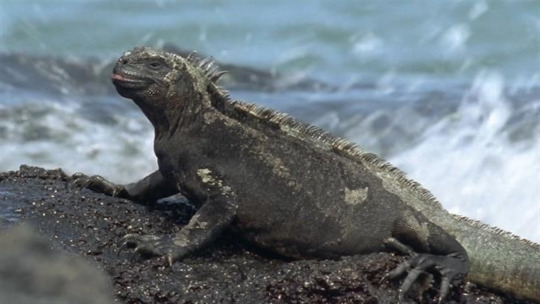
(Image: Doug Jones in The Shape of Water a marine iguana basking on a rock)
Marine iguanas (Amblyrhynchus cristatus) are large lizards native to the Galapagos Islands. They are unique for being the only extant lizards that spend time in the ocean. As of 2017, there are 11 distinct subspecies that are isolated from each other by the islands they live on. Occasionally a member of one subspecies will end up on the wrong island and produce hybrid offspring. Marine iguanas also can but very rarely do hybridize with the land iguanas of the Galapagos, with whom they are believed to share a common ancestor.
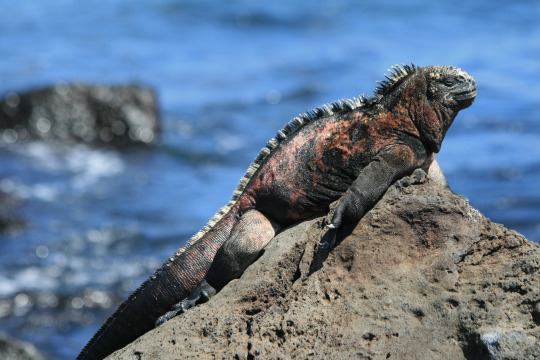
(Image: an iguana perched on a rock
Marine iguanas vary in size based on subspecies, with those from smaller islands reaching a smaller adult size. In general, they race from 12 to 56 cm (4.7 - 22 in) from snout to rear, with a tail ranging from 17 to 84 cm (6.7 - 33.1 in). Males are significantly larger than females, up to twice the weight and noticeably longer. Marine iguanas are robust, with relatively short limbs. Their leg bones are heavy, to provide ballast while swimming. Their tails are laterally flattened and provide propulsion for swimming. They have a row of spines down their backs that provide stability while swimming, similar to a fish's dorsal fin. Their feet have powerful claws and can be used to cling onto and push off of undersea rocks. Marine iguanas were noted by many explorers for their dark color, including Charles Darwin (who referred to them as "clumsy" and "disgusting"). This dark color helps them warm up quickly after diving in the sea.

(image: an iguana going for a swim)
A major feature of the marine iguana is its diet, which is a huge factor in their semiaquatic lifestyle. They feed almost exclusively on green and red algae that grown underwater. To reach the algae, females and smaller males browse the intertidal zone during low tide, while larger males and abnormally large females can swim out to the deeper subtidal zone to forage. They can spend an hour underwater one one breath and dive to 30 m (98 ft), but most dives are much shallower and shorter. Only the largest males swim offshore and dive to significant depths for their food. Because they are positively buoyant, divers must actively swim or cling onto rocks to stay underwater. Most individuals will return to the same spot for feeding and competition over feeding spots have been known to happen. Larger males that swim out for their food have the advantage of less competition for their feeding spots. The species has adapted to be able to fast or subsist on reduced for long periods. During El Nińo, where food supplies can be reduced for years, they will actually shrink, with even their bones getting shorter, then return to full size once the food supply is restored. Because they consume excess salt with their food, marine iguanas have developed the ability to filter the salt out of their blood and expel it through glands in their nostrils. The secreted salt can then be sneezed away. Juveliles spend the first few months of their life feeding on (WARNING: GROSS) the feces of older iguanas. This helps them develop the culture of symbiotic gut bacteria that helps them digest algae. In fact, their digestive systems are so specialized to algae that they can't switch diets.

(image: a marine iguana grazing on algae underwater)
As ectotherms (cold-blooded animals), marine iguanas need to keep themselves warm to survive. The water around the Galapagos is typically around 11-23 degrees C (52-75 F) while their preferred body temp is 35-39 C (95-102 F). This high preferred temperature helps with their digestion. To keep themselves warm, the iguanas spend a lot of their time basking in the sun, especially after swimming. They can also reduce their heart beats while cold to help prevent heat loss. Basking iguanas can cover large beaches. They live in colonies that usually range between 20 and 500 individuals but can sometimes get up to 1000 members. Their biomass to area ratio can be the highest of any reptile. While they are considered gregarious, they display no social behavior such a grooming. The closest they get to a group activity is sleeping next to each other to conserve heat at night. They also get along with other species, such as Darwin's finches, mockingbirds, and crabs who will pick parasites off their skin. Divers may allow cleaner fish to pick off bits of dead skin. Another lizard, the lava lizard, likes to visit colonies to hunt flies attracted to the iguanas. The iguanas allow the much smaller lizards to climb all over them. Marine iguanas often share beaches with Galapagos sea lions, who will occasionally allow the iguanas to climb over them.
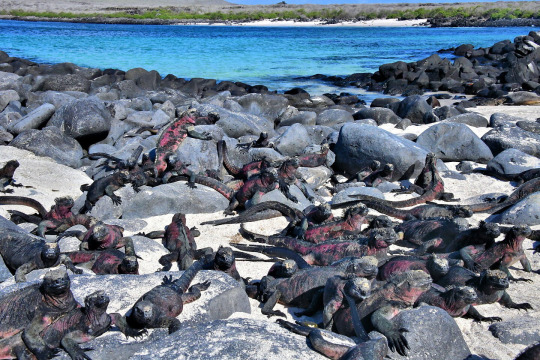
(image: a group of iguanas basking together)
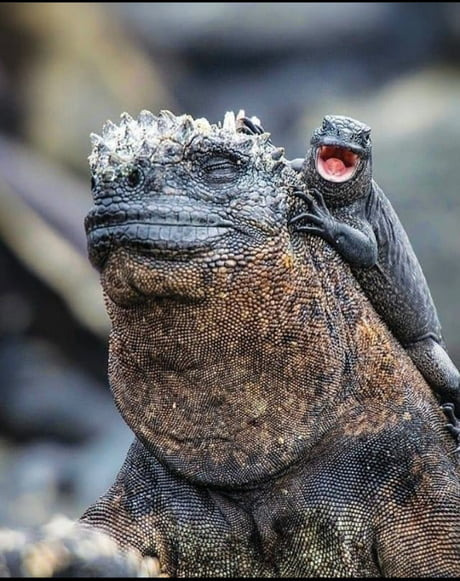
(image: a male marine iguana, identifiable by the rough scales on his head, with a lava lizard climbing on him)
During mating season, male iguanas stop being as chill with their neighbors, attempting to establish a territory and push other males out. They also change from their normal dark appearance to a much brighter coloration. Territories are usually bordered by rocks or crevasses and can be found next to each other in groups. Males will attempt to attract females to their territories while fighting other males to get access to their females. This behavior is called lekking. Females show a distinct preference for larger males and it is the largest males that are most successful at maintaining territories. Medium males are forced to patrol the edges of territories to try to pick up mates while small males often pretend to be female to sneak into another's territory and attempt to mate. Males with territories defend them with special displays where they will raise their dorsal spines and open their mouths while bobbing their heads around. If another male challenges the dominant, they will display at each other. If neither submits, a fight will start. Males fight by headbutting and trying to push each other around. These fights can last for hours and the participants will occasionally take breaks. In most cases, one will eventually display a submissive posture and retreat, though in a few cases the fight has escalated to biting and scratching. When courting a female, a male will nod at her and approach in a sideways walk. Smaller males without territories may also try mating forcibly. Females only mate once per year and will signal rejection to additional suitors by nodding at them.
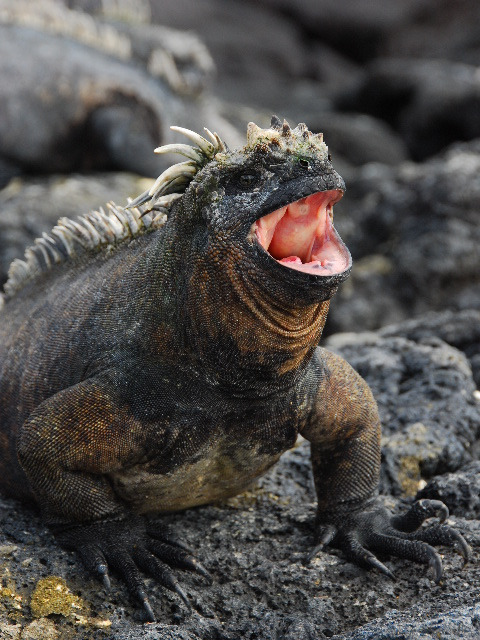
(image: a male performing a territorial display)

(image: two males headbutting each other in a territorial battle)
Mating season usually lasts between December and March. Females will lay eggs about a month after mating. The eggs (usually 2 to 3 but sometimes up to 6) can collectively weigh up to a quarter of the mother's weight, which is very large for an iguana. They are laid well above the tide line and buried in sand or soil. In places with few good nesting sites, mothers will guard their eggs after hatching to make sure other females don't dig therm up to steal the spot. When females fight over nesting spots they are less disciplined than males and will quickly resort to biting. The eggs hatch after 3-4 months. Females reach sexual maturity after 3-5 years while males do so after 6-8 years. They live an average lifespan of 12 years, but can live up to 60.

(image: a female iguana digging her nest)
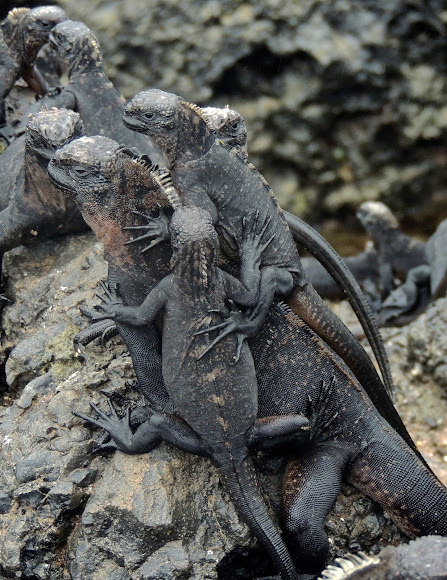
(image: a group of juveniles climbing on each other)
Marine iguanas are classified as vulnerable by the IUCN, while a few populations are instead considered endangered. A major threat to them is warming seas, which can reduce the red and green algae populations and replace them with inedible brown algae, leading to starvation. Marine iguanas only have a few predators and most of them target juveniles or small adults. As a result, the adults demonstrate island tameness, a lack of wariness to potential predators. This has left them vulnerable to predators introduced by humans, such as dogs, cats, rats, and pigs. Despite these invasive predators being present for ver 100 years, they have not developed any anti-predator defenses against them, a phenomenon called ecological naïveté. They also do not fear humans and will allow tourists to approach them, which has led to injuries and the spread of human-introduced diseases. They are protected by laws of Ecuador and most of their range is in protected areas. Efforts to remove invasive predators have seen some benefit. They are difficult to keep in captivity due to their specialized diets, and they have never been bred in captivity.

(image: a male with his bright mating season coloration)
#wet beast wednesday#marine iguana#biology#zoology#ecology#marine biology#galapagos#animal facts#iguana#lizard#reptile#long post
178 notes
·
View notes